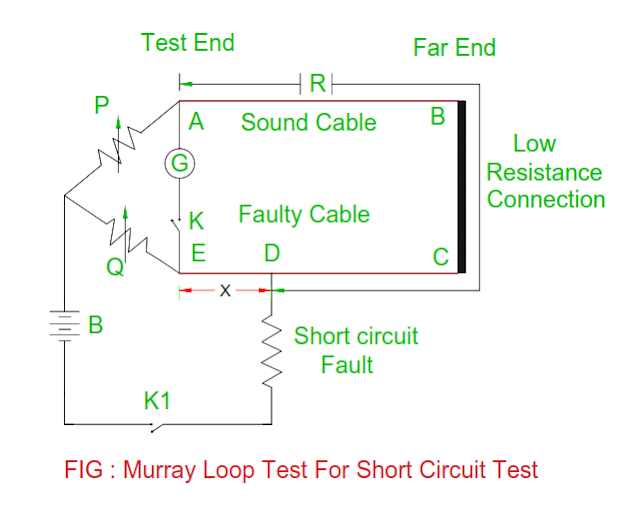The Murray loop test is
useful to find out location of underground fault for earth fault and short
circuit.
Earth fault
Figure shows the circuit diagram for location of
underground fault in the cable.
Let
AB = Sound cable ( without fault )
CD = Faulty cable
P = Variable resistance
Q = Variable resistance
B = Battery ( DC Voltage )
G = Galvanometer
l = length of each cable
2r = Total resistance of sound cable and faulty cable
K1 = Switch
d = Distance of faulty cable from point E = ?
- Let us consider that the earth fault occurs at a distance x from point E.
- The far end C of faulty cable is joined in series with the sound cable by low resistance link.
- There are two variable resistance P and Q connected to cable end A and E respectively.
- This forms PQXR Wheatstone bridge. The four arm of the Wheatstone bridge is
P = Variable resistance
Q = Variable resistance
X = Resistance of cable from point E to point D
R = Resistance of the cable from test end to point D
- The variable resistance P and Q are varied till the galvanometer shows zero deflection after switch K and K1 is closed. For balance conditions
PX = RQ
P / Q = R / X
( P + Q ) / Q = ( R + X ) / X
Here R + x = 2r
( P + Q ) / Q = 2r / X
X = 2r ( P + Q ) / Q …….. ( 1 )
If l is the length of each cable, the resistance per
meter length of cable = r / l
Distance of faulty cable from point E is
d = X / ( r / l ) ……… ( 2 )
From equation ( 1 ) and ( 2 )
d = { 2r ( P + Q ) / Q } / ( r / l )
d = { 2r ( P + Q ) l / r Q }
d = { 2( P + Q ) l /
Q }
d = 2l { ( P + Q )
/ Q }
d = { ( P + Q )
/ Q } × 2l
d = { ( P + Q )
/ Q } × Loop length
d = { ( P + Q )
/ Q } × Length of faulty cable
and length of sound cable
- The fault resistance does not affect the balancing of the bridge circuit.
- If the fault resistance is high, the sensitivity of the bridge is reduced.
Short circuit fault
- The Murray loop test is used to find out location of fault point in the underground cable for short circuit fault.
- Let the P, Q , R and X are the arms of the Wheatstone bridge.
- Note that the fault resistance is in the battery B circuit not in the bridge circuit.
- The balancing of bridge is done by vary the ratio arms P and Q till the galvanometer shows zero reading after closing the switch K and K1.
Let
P = Variable resistance
Q = Variable resistance
X = Resistance of cable from point E to point D
R = Resistance of the cable from test end to point D
PX = RQ
P / Q = R / X
( P + Q ) / Q = ( R + X ) / X
Here R + x = 2r
( P + Q ) / Q = 2r / X
X = 2r ( P + Q ) / Q
X = { ( P + Q )
/ Q } × Loop length
X = { ( P + Q )
/ Q } × Length of faulty cable
and length of sound cable
- The location of fault is find out by adjusting ratio arms P and Q.
You may also like :
Minimum clearance between transmission line conductor
and ground
What do you mean by low voltage, medium voltage & high
voltage?
Right of way in the transmission line










No comments:
Post a Comment